Maytag UXT4130ADW, UXT4136ADW, UXT4130ADS, UXT4130ADB, UXT4136ADS Installation Guide

30" AND 36" (76.2 AND 91.4 CM) RANGE HOOD
Installation Instructions and Use & Care Guide
For questions about features, operation/performance, parts, accessories or service, call: 1-800-253-1301 or visit our website at www.whirlpool.com
In Canada, call 1-800-807-6777 or visit our website at www.whirlpool.ca
HOTTE D’ASPIRATION DE 30" ET 36"
(76,2 ET 91,4 CM)
Instructions d’installation et Guide d’utilisation et d’entretien
Au Canada, pour assistance, installation ou service, composer le 1-800-807-6777 ou visiter notre site Web à www.whirlpool.ca
Table of Contents/Table des matières...................................... |
2 |
Models/Modèles:
UXT4130AD/UXT4136AD
IMPORTANT: READ AND SAVE THESE INSTRUCTIONS.
FOR RESIDENTIAL USE ONLY.
IMPORTANT : LIRE ET CONSERVER CES INSTRUCTIONS.
POUR UTILISATION RÉSIDENTIELLE UNIQUEMENT.
LI32JE/W10646403F
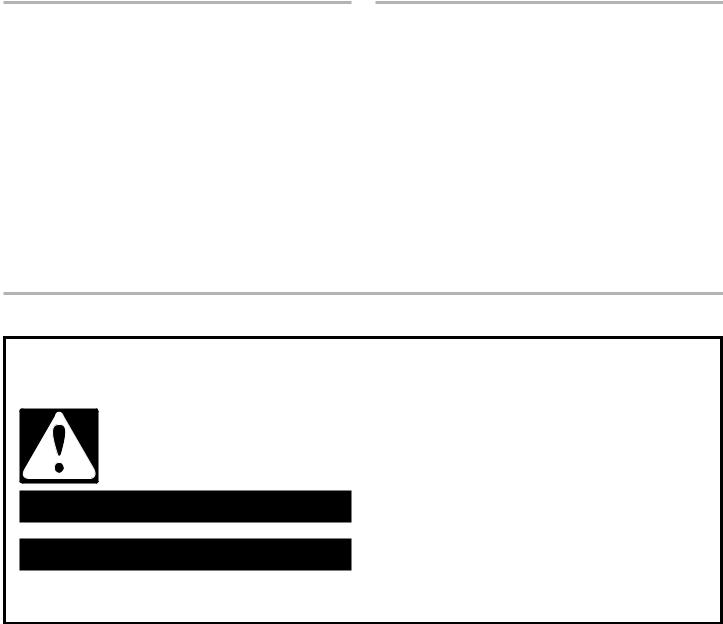
TABLE OF CONTENTS |
|
RANGE HOOD SAFETY.................................................................. |
2 |
INSTALLATION REQUIREMENTS................................................. |
4 |
Tools and Parts............................................................................. |
4 |
Location Requirements................................................................. |
4 |
Venting System............................................................................. |
5 |
Electrical Requirements................................................................ |
6 |
INSTALLATION INSTRUCTIONS................................................... |
7 |
RANGE HOOD USE...................................................................... |
10 |
Range Hood Controls................................................................. |
10 |
RANGE HOOD CARE.................................................................... |
11 |
Cleaning...................................................................................... |
11 |
WIRING DIAGRAM........................................................................ |
12 |
ASSISTANCE OR SERVICE.......................................................... |
13 |
In the U.S.A................................................................................. |
13 |
In Canada.................................................................................... |
13 |
WARRANTY................................................................................... |
14 |
TABLE DES MATIÈRES |
|
SÉCURITÉ DE LA HOTTE DE CUISINIÈRE................................ |
15 |
EXIGENCES D’INSTALLATION.................................................... |
17 |
Outillage et pièces...................................................................... |
17 |
Exigences d’emplacement......................................................... |
17 |
Circuit d’évacuation.................................................................... |
18 |
Spécifications électriques........................................................... |
19 |
INSTRUCTIONS D’INSTALLATION............................................. |
20 |
UTILISATION DE LA HOTTE........................................................ |
23 |
Commandes de la hotte de cuisinière........................................ |
23 |
ENTRETIEN DE LA HOTTE.......................................................... |
24 |
Nettoyage.................................................................................... |
24 |
SCHÉMA DE CÂBLAGE............................................................... |
25 |
ASSISTANCE OU SERVICE.......................................................... |
26 |
Au Canada.................................................................................. |
26 |
GARANTIE..................................................................................... |
27 |
RANGE HOOD SAFETY
Your safety and the safety of others are very important.
many important safety messages in this manual and on your appliance. Always read and obey all safety
safety alert symbol.
alerts you to potential hazards that can kill or hurt you and others.
messages will follow the safety alert symbol and either the word “DANGER” or “WARNING.” mean:
 DANGER
DANGER  WARNING
WARNING
You can be killed or seriously injured if you don't immediately follow instructions.
You can be killed or seriously injured if you don't follow instructions.
All safety messages will tell you what the potential hazard is, tell you how to reduce the chance of injury, and tell you what can happen if the instructions are not followed.
2

State of California Proposition 65 Warnings:
WARNING: This product contains one or more chemicals known to the State of California to cause cancer.
WARNING: This product contains one or more chemicals known to the State of California to cause birth defects or other reproductive harm.
IMPORTANT SAFETY INSTRUCTIONS
WARNING: TO REDUCE THE RISK OF FIRE, ELECTRIC SHOCK, OR INJURY TO PERSONS, OBSERVE THE FOLLOWING:
■Use this unit only in the manner intended by the manufacturer. If you have questions, contact the manufacturer.
■Before servicing or cleaning the unit, switch power off at service panel and lock the service disconnecting means to prevent power from being switched on accidentally. When the service disconnecting means cannot be locked, securely fasten a prominent warning device, such as a tag, to the service panel.
■Installation work and electrical wiring must be done by qualified person(s) in accordance with all applicable codes and standards, including fire-rated construction.
■Do not operate any fan with a damaged cord or plug. Discard fan or return to an authorized service facility for examination and/or repair.
■Sufficient air is needed for proper combustion and exhausting of gases through the flue (chimney) of fuel burning equipment to prevent backdrafting. Follow the heating equipment manufacturer's guideline and safety standards such as those published by the National Fire Protection Association (NFPA), the American Society for Heating, Refrigeration and Air Conditioning Engineers (ASHRAE), and the local code authorities.
■When cutting or drilling into wall or ceiling; do not damage electrical wiring and other utilities.
■Ducted fans must always be vented outdoors.
CAUTION: For general ventilating use only. Do not use to exhaust hazardous or explosive materials and vapors.
CAUTION: To reduce risk of fire and to properly exhaust air, be sure to duct air outside - do not vent exhaust air into spaces within walls or ceilings, attics or into crawl spaces, or garages.
WARNING: TO REDUCE THE RISK OF FIRE, USE ONLY METAL DUCTWORK.
WARNING: TO REDUCE THE RISK OF A RANGE TOP GREASE FIRE:
■Never leave surface units unattended at high settings. Boilovers cause smoking and greasy spillovers that may ignite. Heat oils slowly on low or medium settings.
■Always turn hood ON when cooking at high heat or when flambeing food (i.e. Crepes Suzette, Cherries Jubilee, Peppercorn Beef Flambé).
■Clean ventilating fans frequently. Grease should not be allowed to accumulate on fan or filter.
■Use proper pan size. Always use cookware appropriate for the size of the surface element.
WARNING: TO REDUCE THE RISK OF INJURY TO PERSONS IN THE EVENT OF A RANGE TOP GREASE FIRE, OBSERVE THE FOLLOWING:a
■SMOTHER FLAMES with a close fitting lid, cookie sheet, or metal tray, then turn off the burner. BE CAREFUL TO PREVENT BURNS. If the flames do not go out immediately, EVACUATE AND CALL THE FIRE DEPARTMENT.
■NEVER PICK UP A FLAMING PAN - you may be burned.
■DO NOT USE WATER, including wet dishcloths or towels - a violent steam explosion will result.
■Use an extinguisher ONLY if:
–You know you have a class ABC extinguisher, and you already know how to operate it.
–The fire is small and contained in the area where it started.
–The fire department is being called.
–You can fight the fire with your back to an exit.
aBased on "Kitchen Fire Safety Tips" published by NFPA.
■ WARNING: To reduce the risk of fire or electrical shock, do not use this fan with any solid-state speed control device.
READ AND SAVE THESE INSTRUCTIONS
3
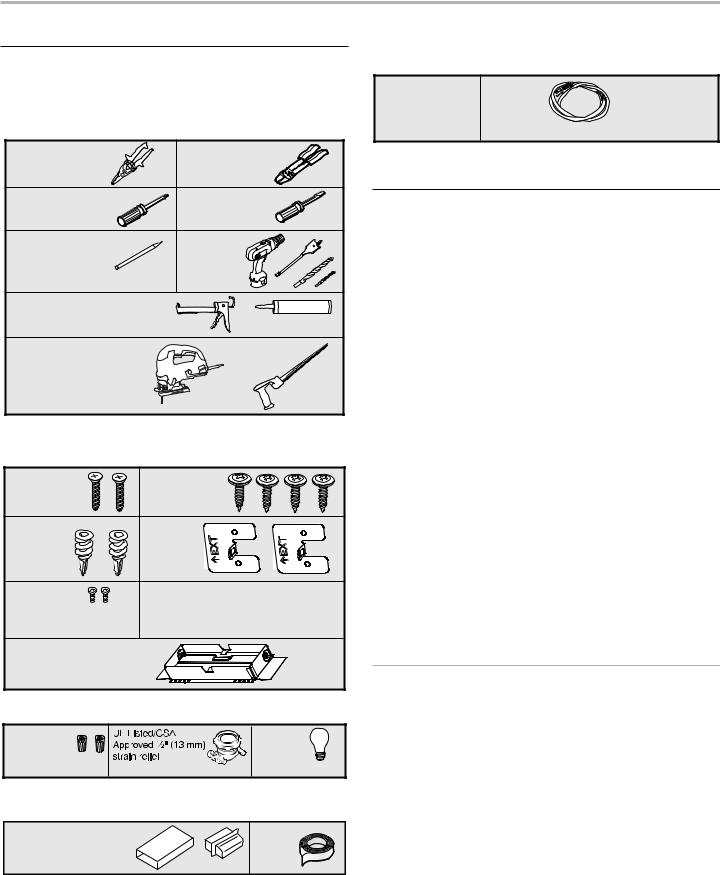
INSTALLATION REQUIREMENTS
Tools and Parts
Gather the required tools and parts before starting installation. Read and follow the instructions provided with any tools listed here.
Tools needed
Metal snips |
Wire stripper |
|
#2 Phillips |
Flat-blade |
|
screwdriver |
screwdriver |
|
Pencil |
Drill with ¹⁄ " |
|
(3 mm), ¹⁄ " |
||
|
||
|
(13 mm) |
|
|
and 1¹⁄ " |
|
|
(3 cm) bits |
|
Caulking gun and weatherproof |
|
|
caulking compound |
|
|
Jigsaw or keyhole saw |
|
Parts supplied
Remove parts from package. Check that all parts are included.
#8-18 x 1" |
#8-18 x ⁄ " |
(4.2 x 25 mm) |
(4.2 x 16 mm) |
flat-head screws |
truss-head screws |
Drywall |
Mounting |
anchors |
brackets |
Short Phillips head screws
3¹⁄ " x 10" (8.3 x 25.4 cm) rectangular damper
Parts needed
UL Listed/CSA |
120V, 75W |
|
maximum, |
||
Approved |
||
type |
||
wire connectors |
||
E26 lamp |
||
|
For 31/4" x 10" (8.3 x 25.4 cm) rectangular vented installations
3¹⁄ " x 10" |
Duct tape |
(8.3 x 25.4 cm) rectangular |
|
metal vent system with |
|
wall or roof cap |
|
Optional accessories
Charcoal |
Power |
Stainless steel |
filter kit |
cord kit |
cleaner and |
Part Number |
Part Number |
polish |
W10355450* |
W10355452* |
Part Number |
|
|
31462A* |
*For information on ordering, see the “Assistance or Service” section.
Location Requirements
IMPORTANT: Observe all governing codes and ordinances.
■■ It is the installer’s responsibility to comply with installation clearances specified on the model/serial rating plate. The model/serial/rating plate is located inside the range hood on the left wall.
■■ Range hood location should be away from strong draft areas, such as windows, doors, and strong heating vents.
■■ Cabinet opening dimensions that are shown must be used. Given dimensions provide minimum clearance. Consult the cooktop/range manufacturer installation instructions before making any cutouts.
■■ This range hood is recommended for use with cooktops with a maximum total rating of 40,000 BTUs or less.
■■ Grounded electrical outlet is required. See “Electrical Requirements” section.
■■ All openings in ceiling and wall where range hood will be installed must be sealed.
■■ These range hoods are factory set for vented installations. Models that are capable of being installed as non-vented (recirculating) require charcoal filters. See the “Assistance or Service” section for information on ordering charcoal filters.
For Mobile Home Installations
The installation of this range hood must conform to the Manufactured Home Construction Safety Standards, Title 24 CFR, Part 328 (formerly the Federal Standard for Mobile Home Construction and Safety, title 24, HUD, Part 280),
or when such standard is not applicable, the standard for Manufactured Home Installation 1982 (Manufactured Home Sites, Communities and Setups) ANSI A225.1/NFPA 501A or latest edition, or with local codes.
Product Dimensions
6⁄" (16.7 cm) or
2"  9⁄" (24.4 cm)
9⁄" (24.4 cm)
(5.1 cm)
1" (2.5 cm)
4¹ ⁄" |
1" |
|
|
(12.5 cm) |
9" |
||
(2.5 cm) |
|||
|
|||
|
|
(22.9 cm) |
29¹ ⁄" (76.0 cm) or |
1¹⁄" |
|
35¹ ⁄" (91.0 cm) |
(3.8 cm) |
18⁄" |
|
|
(47.3 cm) |
4
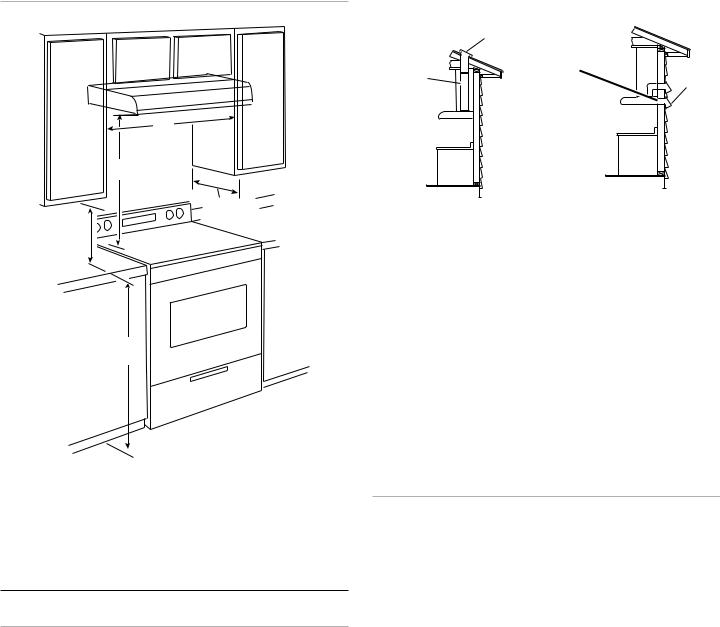
Installation Clearances
C
A
D
B
E
A.24" (61 cm) minimum distance from electric cooking surface 24" (61 cm) minimum distance from gas cooking surface
30" (76.2 cm) suggested maximum above the cooking surface
B.18" (45.7 cm) minimum clearance - upper cabinet to countertop
C.30" (76.2 cm) minimum cabinet opening width for 30" (76.2 cm) models and 36" (91.4 cm) minimum cabinet width for 36" (91.4 cm) models
D.12" (30.5 cm) cabinet depth
E.36" (91.4 cm) base cabinet height
Venting System
Venting Methods
NOTES:
■■ Flexible vent is not recommended. Flexible vent creates both back pressure and air turbulence that greatly reduce performance.
■■ The vent system is optional for this model.
Vent system can terminate either through the roof or wall. Use 31/4" x 10" (8.3 x 25.4 cm) rectangular with a maximum vent length of 35 ft (10.7 m).
Top Venting
B
A |
Wall Venting
A
B
A. 31/4" x 10" (8.3 x 25.4 cm) |
A. 31/4" x 10" (8.3 x 25.4 cm) |
rectangular vent through the |
rectangular vent through |
roof (purchased separately) |
the wall or out the top |
B. Roof cap with damper |
(purchased separately) |
(purchased separately) |
B. Wall cap with damper |
|
(purchased separately) |
Cold Weather Installations
An additional backdraft damper should be installed to minimize backward cold air flow and a thermal break should be installed to minimize conduction of outside temperatures as part of the vent system. The damper should be on the cold air side of the thermal break.
The break should be as close as possible to where the vent system enters the heated portion of the house.
Makeup Air
Local building codes may require the use of makeup air systems when using ventilation systems greater than
specified CFM of air movement. The specified CFM varies from locale to locale. Consult your HVAC professional
for specific requirements in your area.
Venting Requirements
■■ Vent system must terminate to the outdoors, except for non-vented (recirculating) installations.
■■ Do not terminate the vent system in an attic or other enclosed area.
■■ Do not use a 4" (10.2 cm) laundry-type wall cap.
■■ Use 31/4" x 10" (8.3 x 25.4 cm) rectangular metal vent, depending on your installation requirement. Rigid metal vent is recommended. Plastic or metal foil vent is not recommended.
■■ The length of vent system and number of elbows should be kept to a minimum to provide efficient performance.
For the most efficient and quiet operation:
■■ Use no more than three 90° elbows.
■■ Make sure there is a minimum of 24" (61 cm) of straight vent between the elbows if more than 1 elbow is used.
■■ Do not install 2 elbows together.
■■ Use clamps or duct tape to seal all joints in the vent system.
■■ The vent system must have a damper. If roof or wall cap has a damper, do not use damper supplied with the range hood.
■■ Use caulking to seal exterior wall or roof opening around the cap.
5
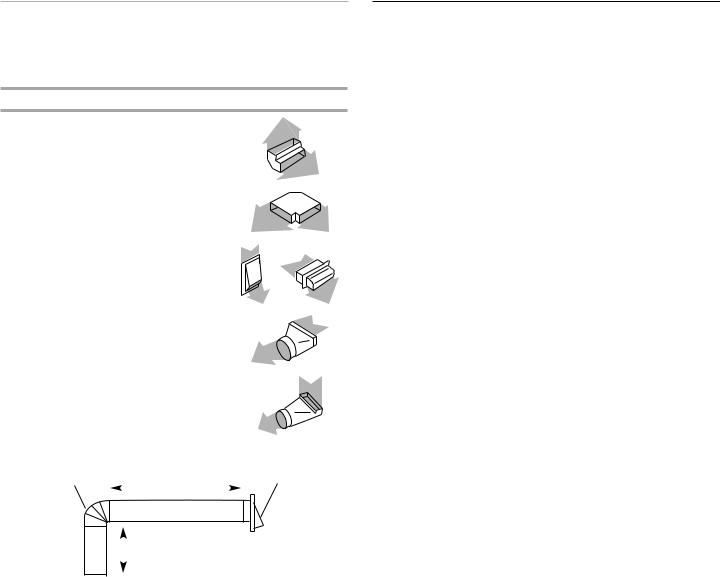
Calculating Vent System Length
To calculate the length of the system you need, add the equivalent feet (meters) for each vent piece used in the system.
Vent System
Vent Piece
90° elbow |
5 ft (1.5 m) |
||||||||||
|
|
|
|
|
|
|
|
|
|
|
|
31/4" x 10" (8.3 cm x |
12 ft (3.7 m) |
||||||||||
25.4 cm) flat elbow |
|
|
|
|
|
||||||
|
|
|
|
|
|
|
|
|
|
|
|
7" (17.8 cm) wall cap |
0 ft (0 m) |
||||||||||
|
|
|
|
|
|
|
|
|
|
|
|
31/4" x 10" (8.3 cm x |
4.5 ft (1.4 m) |
||||||||||
25.4 cm) to 7" (17.8 cm) |
|
|
|
|
|
||||||
|
|
|
|
|
|
|
|
|
|
|
|
31/4" x 10" (8.3 cm x |
5 ft (1.5 m) |
||||||||||
25.4 cm) to 7" (17.8 cm) |
|
|
|
|
|
||||||
90° elbow |
|
|
|
|
|
||||||
|
|
|
|
|
|
|
|
|
|
|
|
Example vent system |
|
|
|
|
|
||||||
90˚ elbow |
|
|
|
|
|
|
|
|
Wall cap |
||
|
|
|
|
|
|
|
6 ft (1.8 m) |
|
|
|
|
|
|
|
|
|
|
|
|
||||
|
|
|
|
|
|
|
|
|
|
||
|
|
|
|
|
|
||||||
|
|
|
|
||||||||
|
|
|
|
|
|||||||
|
|
2 ft (0.6 m) |
|
||||||||
|
|
|
|
|
|
|
|
|
|
|
|
|
|
|
|
|
|
|
|
|
|
|
|
1 - 90° elbow |
|
= 5 ft (1.5 m) |
|||||||||
1 - wall cap |
|
= 0 ft (0 m) |
|||||||||
8 ft (2.4 m) straight |
|
= 8 ft (2.4 m) |
|||||||||
|
|
|
|
|
|
|
|
|
|
|
|
System length |
|
= 13 ft (3.9 m) |
|||||||||
|
|
|
|
|
|
|
|
|
|
|
|
Maximum Recommended Length |
|||||||||||
|
|
|
|
|
|
|
|
|
|
|
|
31/4" x 10" (8.3 x 25.4 cm) |
|
= 35 ft (10.7 m) |
|||||||||
Rectangular Vent |
|
|
|
|
|
||||||
Electrical Requirements
Observe all governing codes and ordinances.
Ensure that the electrical installation is adequate and in conformance with National Electrical Code, ANSI/NFPA 70 (latest edition) or CSA Standards C22.1-94, Canadian
Electrical Code, Part 1 and C22.2 No. 0-M91 (latest edition), and all local codes and ordinances.
If codes permit and a separate ground wire is used, it is recommended that a qualified electrician determine that the ground path is adequate.
A copy of the above code standards can be obtained from:
National Fire Protection Association
1 Batterymarch Park
Quincy, MA 02169-7471
CSA International
8501 East Pleasant Valley Road
Cleveland, OH 44131-5575
■■ A 120 volt, 60 Hz., AC only, 15-amp, fused electrical circuit is required.
■■ If the house has aluminum wiring, follow the procedure below:
1.Connect a section of solid copper wire to the pigtail leads.
2.Connect the aluminum wiring to the added section of copper wire using special connectors and/or tools
designed and UL Listed for joining copper to aluminum.
Follow the electrical connector manufacturer’s recommended procedure. Aluminum/copper connection must conform
with local codes and industry accepted wiring practices.
■■ Wire sizes and connections must conform with the rating of the appliance as specified on the model/serial/rating plate. The model/serial/rating plate is located inside the range hood on the left wall.
■■ Wire sizes must conform to the requirements of the National Electrical Code, ANSI/NFPA 70 (latest edition) or CSA Standards C22. 1-94, Canadian Electrical Code, Part 1
and C22.2 No. 0-M91 (latest edition), and all local codes and ordinances.
6

INSTALLATION INSTRUCTIONS
NOTES:
■■ Depending on your model, determine which venting method to use: roof, wall or non-vented (recirculating).
■■ It is recommended that the vent system be installed before the range hood is installed. Go to “Venting System” in the “Installation Requirements” section if you need assistance.
■■ Before making cutouts, make sure there is proper clearance within the ceiling or wall for the vent system.
1. Disconnect Power
 WARNING
WARNING
Electrical Shock Hazard Disconnect power before servicing.
Replace all parts and panels before operating.
Failure to do so can result in death or electrical shock.
2. Mark Hole Locations
Align the exterior edge of the mounting brackets with the exterior edges of the upper cabinet.
IMPORTANT: The brackets should touch the upper cabinet. With a pencil, mark the upper holes on the brackets.
3. Install Brackets
■■ Using a #2 Phillips screwdriver, install the drywall anchors.
■■ Using #8-18 x 1" (4.2 x 25 mm) flat-head #2 Phillips screws, install the mounting brackets using the upper holes.
NOTE: For installations to a surface other than drywall, it is recommended that a qualified contractor determine the anchoring method.
4. Prepare Range Hood
■■ Set the range hood on its back on a covered surface.
■■ Using a #2 Phillips screwdriver, remove the rectangular damper attached with 3.5 x 9.5 mm screws.
■■ Using a #2 Phillips screwdriver, remove the electrical box cover.
■■ Using a flat-blade screwdriver, remove the appropriate power supply knockout.
7

5. Mark Hole Locations
Lift the range hood into place and insert the mounting bracket tabs through the slots in the back of the range hood.
A
90˚
C  C B
C B
D
D
Hold the range hood firmly in place with one hand and bend each mounting tab (A) upward approximately 90°.
OPTIONAL: Mark the hole in each mounting tab. Mark the hole at the power supply knockout (B).
For a non-vented (recirculating) installation: Go to Step 7.
For a top vented installation: Mark the 4 vent hole locations (C) on the top of the range hood.
For a rear vented installation: Mark the 4 vent hole locations (D) on the rear of the range hood.
OPTIONAL: Mark the hole in each mounting tab. Remove the range hood and set it aside.
6. Mark and Cut Vent Opening
31/4" x 10" (8.3 x 25.4 cm) Rectangular Vent System
■■ Using a 1/2" (13 mm) drill bit, drill a hole in each of the dots marked previously on either the wall or upper cabinet. Using the outside edges of the holes, mark the vent opening.
■■ Using a jigsaw or keyhole saw, cut the vent opening.
7. Drill Electrical Opening
Using a 11/4" (3 cm) drill bit, drill the hole in the dot marked previously at the electrical strain relief.
OPTIONAL: Using a 1/8" (3 mm) drill bit, drill pilot holes for the dots marked previously at each mounting tab at an approximate 45° angle in an upward direction.
8
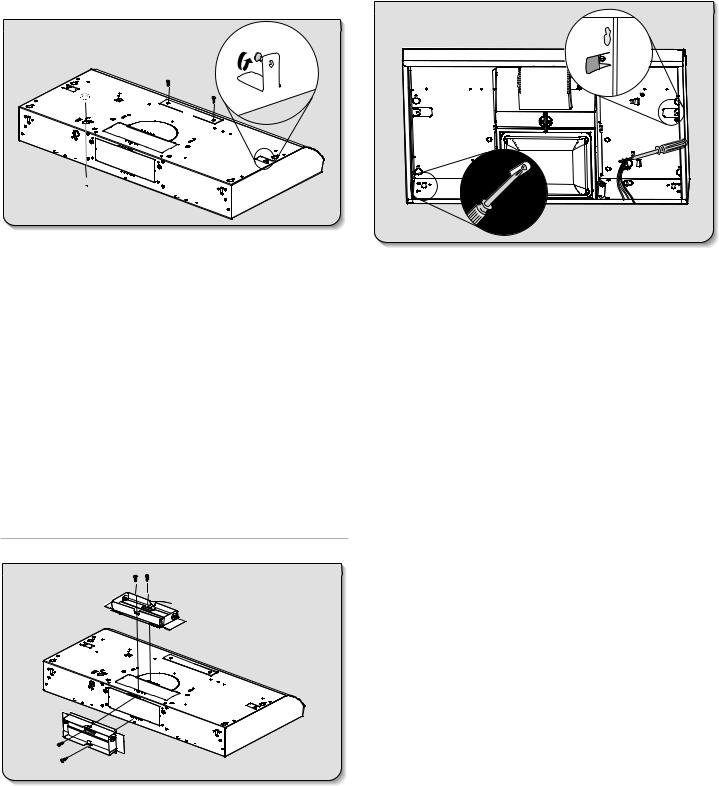
8.Prepare Range Hood Vents and Mounting Tabs
x2 E
D
C
B
A 

■■ Install Strain Relief
Install a UL Listed/CSA Approved 1/2" (13 mm) strain relief (A).
■■ Mounting Tabs
Start a #8-18 x 5/8" (4.2 x 16 mm) truss-head screw into the mounting tab (D) on each side of the range hood as shown in the inset. Insert the screws approximately 2 turns into the mounting tab holes.
■■ Non-vented (Recirculating) Installations
Using a #2 Phillips screwdriver remove the 2 screws and remove the top, front rectangular vent cover (D). Go to Step 12.
■■ 31/4" x 10" (8.3 x 25.4 cm) Rectangular Vent Installations
For top vent installations, remove the top rectangular vent knockout (C).
OR
For wall vent installations, remove the rear rectangular vent knockout (B).
9. Attach Vent Damper or Transition
31/4" x 10" (8.3 x 25.4 cm) Rectangular Vent Damper
Using (2) short Phillips head screws, install the 31/4" x 10" (8.3 x 25.4 cm) rectangular damper over the top or rear vent knockout removed in Step 8.
NOTE: If the wall cap used has a damper and it interferes with the rectangular damper, remove the rectangular damper flap.
10. Mount Range Hood
■■ Lift the range hood into place, positioning the rear slots over the mounting brackets.
■■ Using a Phillips screwdriver, push on the screws that are started into the top mounting tabs and bend the tabs against the cabinet side walls. Attach the screws to the cabinet side walls.
IMPORTANT: Do not overtighten the screws.
■■ For direct wire installations, run the home power supply cable according to the National Electric Code or CSA standards and local codes and ordinances. There must be enough wiring from the fused disconnect (or circuit breaker) box to make the connection in the range hood electrical terminal box.
■■ Tighten the strain relief screws.
NOTE: Do not reconnect power until the installation is complete.
OPTIONAL: If you prefer, bend the rear tabs against the rear of the range hood and attach to the wall using #8-18 x 5/8" (4.2 x 16 mm) truss-head screws.
11. Connect Vent System
■■ Connect the ventwork to the range hood.
■■ Seal joints with vent clamps or duct tape to make secure and airtight.
■■ Check that the backdraft dampers work properly.
9
